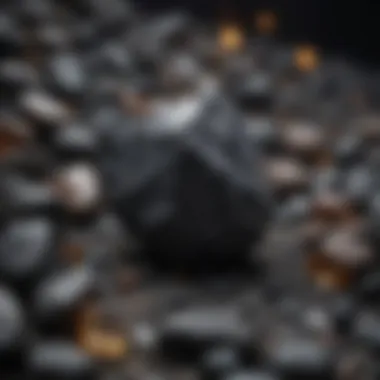Exploring Dark Crystals and Stones: Properties and Significance


Intro
The realm of dark crystals and stones is both fascinating and complex. These geological formations have captivated humans for centuries, serving various purposes in different cultures. From the mystical to the purely aesthetic, their significance cannot be overstated. Understanding these stones requires an exploration of their properties, origins, and the roles they play in our lives.
In this article, we will navigate through the attributes of dark crystals, their geological formation, and their metaphysical aspects. You will find a wealth of information geared towards enthusiasts and collectors alike. We will also discuss identification techniques, providing you the tools to recognize these stones with confidence. Join us as we uncover the mysteries of dark crystals and stones.
Preamble to Dark Crystals and Stones
Dark crystals and stones hold a unique place in both geological and cultural landscapes. Their significance extends beyond mere aesthetics; they are revered for their properties, history, and possible metaphysical benefits. Understanding these aspects can greatly enhance appreciation for dark crystals and stones.
The types of dark crystals, like Obsidian, Black Tourmaline, Onyx, and Jet, are often coveted by rock and mineral collectors. Each type carries its own characteristics, such as color variation, transparency, and luster. This variety creates a desire among collectors to explore and understand more about them.
Delving into the geological formation of these stones provides insight into their origins. Many dark crystals form through volcanic activity or metamorphism, showcasing the Earth's dynamic processes. Collecting them can connect enthusiasts not only with physical artifacts of the Earth but also with its history.
Additionally, there is a rich cultural backdrop associated with dark crystals and stones. Ancient cultures utilized these materials in spiritual practices and trade routes, highlighting their importance in human history. Today, these stones find modern applications in jewelry and various industries, proving that their utility remains relevant.
Through this exploration, we aim to unveil the intricate details of dark crystals and stones. Understanding their significance, both scientifically and culturally, encourages deeper connections for collectors and enthusiasts alike.
"Dark crystals hold secrets of the Earth, waiting to be uncovered."
Geological Formation of Dark Crystals
Understanding the geological formation of dark crystals is essential for anyone interested in their unique attributes and cultural significance. Dark crystals, such as obsidian and black tourmaline, form from specific geological processes that dictate their characteristics and distribution. These processes not only shape the crystals physically but also contribute to their metaphysical properties. Thus, a grounding in geology enhances our appreciation of these minerals, revealing intricate connections between the earth's dynamics and the beauty found in dark stones.
The Role of Minerals in Crystal Growth
Crystal growth is significantly influenced by the minerals present in the surrounding environment. Dark crystals typically originate from silica-rich materials, which crystallize under varying conditions such as temperature and pressure. This process results in unique mineral structures that contribute to a crystal's final appearance. For example, obsidian is primarily made of silica and forms when volcanic lava cools rapidly. Conversely, black tourmaline is a complex boron silicate mineral that requires specific chemical conditions to form. Understanding these mineral compositions helps collectors and enthusiasts identify and appreciate the characteristics of different dark crystals.
Common Geological Processes
Several geological processes lead to the formation of dark crystals. Each process has its distinct characteristics and outcomes, contributing uniquely to the world of geology and crystal enthusiasts.
Volcanic Activity
Volcanic activity plays a crucial role in the formation of certain dark crystals, notably obsidian. This glassy volcanic rock forms from rapidly cooling lava during explosive eruptions. The key characteristic of obsidian is its smooth, shiny surface, which often exhibits a jet-black hue, though color variation can occur. Such unique surfaces make obsidian particularly popular among collectors.
However, the rapid cooling process can also lead to challenges, as bubbles may form within the stone. This affects its transparency and value. Nonetheless, the aesthetic appeal and rich history of obsidian make it a prominent highlight in dark crystal collections.
Metamorphism
Metamorphism is another significant geological process that contributes to dark crystal formation. This process occurs when existing rocks undergo changes in temperature and pressure over time. Black tourmaline, for instance, forms through metamorphic processes involving granite or other igneous rocks. Its robust structure and natural durability make it a favored choice for both collectors and those who seek its metaphysical properties. This process creates unique features, such as elongated crystal formations, that are highly sought after.
While metamorphically altered stones often boast impressive luster, the conditions required for their formation can limit accessibility. Consequently, collectors sometimes face challenges in sourcing high-quality specimens, but the challenge enhances the excitement of the search.
Sedimentary Formation
Sedimentary formation contributes to the creation of certain dark stones, including jet. Jet is a form of lignite, formed from the compacted remains of decaying plants, and its genesis involves long-term sediment accumulation in low-oxygen environments, such as peat bogs. A prominent characteristic of jet is its lightweight and soft texture, which allows for intricate carvings in jewelry.
However, this relative softness also poses a disadvantage, as jet can be sensitive to scratches and environmental exposure. Still, it remains a popular choice due to its historical significance in jewelry-making and cultural practices. Its unique origin and formation process make jet a fascinating topic for exploration among collectors.
In summary, the geological processes responsible for dark crystal formation are diverse and complex. From volcanic activity producing obsidian to metamorphic forces shaping black tourmaline and sedimentary processes creating jet, each dark crystal has a distinct story rooted in the earth's history. This knowledge not only enriches appreciation among collectors but also highlights the intricate connections between geology and the natural beauty of these invaluable stones.
Classification of Dark Crystals
Classifying dark crystals is essential for understanding their distinct properties and applications. Each type has unique characteristics that can influence everything from aesthetic appeal to practical uses. Not only do these classifications help collectors identify their specimens, but they also assist enthusiasts in grasping the geological and metaphysical significance of these materials. By categorizing these crystals, we can appreciate the complexities of their formation, their role in various cultures, and their functions in modern applications.
Types of Dark Crystals


Obsidian
Obsidian is a volcanic glass, formed when lava cools rapidly. This gives it a smooth, glassy texture and a beautiful shine. Its black coloration often indicates high silica content, making it both a stunning and durable choice for collectors. Obsidian is famous for its sharp edges when fractured, and it was historically used for making weapons and tools.
The key characteristic of obsidian is its ability to fracture conchoidally, resulting in sharp edges. This property makes it valuable for purposes beyond aesthetics, including surgical instruments in modern medicine. However, the fragility of obsidian can be a downside, as it is prone to chipping if not handled carefully.
Black Tourmaline
Black tourmaline, known for its strong protective qualities, is a favorite among crystal enthusiasts. It is often believed to absorb negative energy, making it a popular choice for those seeking grounding and protection. The crystalline structure of black tourmaline gives it a unique striated appearance, contributing to its visual appeal.
The primary feature of black tourmaline is its capacity to stabilize electrical energy, making it helpful in various electronic applications. Its robust nature makes it highly durable, yet it can be challenging to find high-quality specimens without imperfections, which can diminish its aesthetic value.
Onyx
Onyx is a form of chalcedony, characterized by its layered appearance. The dark bands running through onyx give it a striking visual appeal, making it a favored choice for jewelry and embellishments. Onyx is often associated with inner strength and self-control.
A key advantage of onyx is its availability in various shades, contributing to its versatility. However, one downside is that while it is generally durable, certain specimens can be more prone to scratching if not stored properly. This is a consideration for collectors as they build their collections.
Jet
Jet is a fossilized wood that forms under high pressure and temperature over millions of years. This organic gemstone is lightweight and has a rich black color, making it popular in jewelry making. It is often linked to protective energies and emotional healing.
The notable aspect of jet is its unique origin, giving it a different character than typical minerals. However, its softness can be a limitation, as it can be scratched easily. Therefore, careful handling and storage are necessary to preserve its beauty.
Distinguishing Characteristics
Color Variation
Color variation in dark crystals can range from deep black to browns, blues, and even greens. This variability can arise from mineral inclusions or the geological environment in which the crystal formed. The color intensity often influences its value in the market.
As a distinguishing characteristic, color variation offers collectors a way to sort and categorize their specimens. It adds to the diversity in collections, reflecting different geological processes. However, this variation can complicate identification for newcomers.
Transparency and Opacity
The transparency and opacity of dark crystals are crucial for evaluating their aesthetic and market value. Some crystals may exhibit translucency, while others may appear completely opaque. For example, obsidian is typically opaque, whereas onyx may present bands of translucency.
Understanding these properties helps collectors make informed decisions based on visual preferences and structural qualities. Yet, more opaque specimens may lack the light-catching features that some collectors desire.
Luster
Luster refers to how light reflects from the surface of a crystal. Dark crystals can have various luster types, including vitreous, glossy, and dull. This characteristic significantly affects the crystal's overall appeal.
Easily observable during inspection, luster plays a vital role in the perceived quality of dark crystals. While strong luster indicates a well-formed crystal, duller specimens can sometimes be overlooked by enthusiasts looking for more vibrant options. Maintaining knowledge of these traits is essential for both collectors and sellers in the crystallography market.
Physical and Chemical Properties
Understanding the physical and chemical properties of dark crystals is essential for enthusiasts and collectors. These properties not only define the crystals' behavior but also influence their value and applications. For collectors, knowing the hardness, durability, and chemical makeup of their stones is crucial when determining their significance and the best practices for care.
Hardness and Durability
The hardness of a crystal indicates its resistance to scratching and wear. This property is often measured using the Mohs scale, which ranges from 1 to 10. Dark crystals like Black Tourmaline score around 7 on this scale, making them suitable for everyday wear in jewelry. Their durability is an important consideration for collectors, as higher hardness translates into less prone to damage over time.
In contrast, Obsidian, though stunning, ranks lower on the Mohs scale at about 5.5 to 6. This means it is more susceptible to scratches and damage, making it less ideal for high-traffic jewelry pieces. Proper handling and storage practices are necessary to maintain the physical integrity of these lesser hard crystals.
Additionally, the durability of a crystal can be attributed to its crystal structure. Many dark crystals form strong, interlocking structures that contribute to their overall toughness.
Chemical Composition


The chemical composition of dark crystals plays a pivotal role in determining their attributes. Each type of crystal has a unique formula, which influences both its appearance and properties. For instance, Onyx is primarily composed of silicon dioxide, which gives it a striking look often enhanced by banding patterns.
Contrary to this, Jet, formed from decaying wood under heat and pressure, has organic roots. Its composition affects not only its color but also its weight and luster. Varied mineral content also leads to diverse types of inclusions, giving each stone its unique character.
Understanding these chemical structures allows collectors to better appreciate the complexity behind each gemstone. In addition, it aids in the identification of potential treatment processes that might have been applied to enhance their appearance.
"The intrinsic qualities of dark crystals are woven intricately into their elemental makeup, which determines both aesthetic appeal and practicality in use."
Historical Significance of Dark Crystals
Dark crystals and stones hold a significant place in human history and culture. Their historical value extends beyond mere aesthetics, influencing spiritual practices and trade. This significance provides insight into human civilization's evolving relationship with nature, and it also illustrates how these stones were not only seen as objects of beauty but also as symbols of power and protection.
Use in Ancient Cultures
Spiritual Practices
In many ancient cultures, dark crystals served important roles in spiritual practices. For instance, black tourmaline was often used for its believed protective properties. It was thought to repel negative energies, which made it a popular choice for rituals and ceremonies aimed at fostering spiritual health. This characteristic serves as a beneficial aspect of its use, allowing practitioners to feel more secure in their environment.
A unique feature of spiritual practices involving dark crystals is the ritualized cleansing. This involves various methods such as smoke, water, or even sunlight to recharge the stones. This is seen by many as necessary to maintain the crystal’s energy, but it also requires care and attention, which might be seen as a drawback for some.
Trade Routes
Trade routes played a vital role in spreading the knowledge and use of dark crystals. Ancient civilizations such as the Egyptians and Romans valued these materials not just for their beauty but for their perceived metaphysical properties. This led to the establishment of trade systems that connected distant lands, enhancing cultural exchanges.
One key characteristic of these trade routes is their contribution to the commercialization of dark crystals. The influx of these stones into various markets allowed for the development of distinct styles and applications. However, this commercialization also poses a risk where the spiritual significance might be overshadowed by mere market dynamics.
Modern Applications
As time progressed, the applications of dark crystals expanded, reflecting changing societal values and technological advancements.
Jewelry and Ornamentation
In contemporary society, dark crystals are prominently featured in jewelry and ornamentation. Their unique colors and textures make them attractive choices for both casual and formal wear. For collectors, pieces featuring obsidian or onyx can often be seen as symbols of sophistication.
The prominence of these materials in jewelry also showcases their durability, making them ideal for everyday use. However, this widespread use may sometimes detract from their perceived uniqueness and spiritual attributes.
Industrial Uses
Additionally, dark crystals have practical industrial uses. For instance, certain types of black tourmaline are utilized in electronic applications for its piezoelectric properties. This makes it a sought-after material in manufacturing environments.
The growth of technology-related industries emphasizes this facet of dark crystals. However, this industrial demand can sometimes lead to ethical concerns regarding sourcing and the balance between commercial exploitation and preservation.
Metaphysical Attributes of Dark Crystals
Dark crystals and stones hold a unique place in metaphysical practices. Their attributes often relate to their ability to enhance various aspects of one's spiritual experience. For many enthusiasts and collectors, these metaphysical properties can deepen their connection to the stones. The beliefs surrounding these attributes often focus on two main themes: protection and grounding, as well as enhancing intuition. Understanding these elements can enrich one's appreciation of the crystals themselves, beyond their physical beauty.
Protection and Grounding
Many people believe that dark crystals provide a sense of protection. This characteristic is often associated with the energetic properties of these stones, which are thought to create a protective barrier against negative influences. Crystals like Black Tourmaline and Obsidian are especially noted for their grounding abilities. They are said to help individuals stay rooted and stable, even in challenging situations.
Here are some benefits commonly attributed to protection and grounding:
- Emotional Stability: Dark crystals can help to stabilize emotions. Many users claim that these stones help them to feel more secure, reducing feelings of anxiety and fear.
- Shield Against Negativity: The belief exists that dark stones can absorb negative energies. Their dense composition is thought to act like a sponge for harmful vibes, which makes them desirable for those feeling overwhelmed by negativity from various sources.
- Enhanced Focus: These stones are often used during meditation. Collectors believe they help improve concentration, making it easier to focus on spiritual goals or personal reflection.
Enhancing Intuition
Another key attribute of dark crystals is their ability to enhance intuition. Many users describe experiences where they feel more connected to their inner selves when using crystals like Onyx or Jet. This connection is thought to provide clarity and insight into one’s thoughts and feelings.


The common beliefs around intuition enhancement include:
- Heightened Awareness: Practitioners often report an increased ability to perceive subtle cues in their environment, which can guide decision-making effectively.
- Intuitive Decision-Making: Users feel more confident in their choices, attributing this intuition to the energy of the stones.
- Deeper Meditation: Dark crystals are considered effective tools for meditation, assisting users in accessing deeper states of conscious awareness.
Dark crystals represent not only geological wonders but also significant metaphysical tools. Whether for collectors or those embracing spiritual practices, understanding these attributes can enhance their experiences. As knowledge around these properties grows, the appreciation for dark crystals continues to expand, illustrating that their value transcends mere aesthetics.
Collecting Dark Crystals and Stones
The act of collecting dark crystals and stones is not just a hobby, but a pursuit of knowledge, appreciation, and connection with the natural world. These stones, often steeped in history and mystique, provide collectors with a tangible link to ancient practices and modern uses. Collecting these unique specimens enriches one’s understanding of geology, mineralogy, and the cultural significance of stones in different contexts. Moreover, it fosters a sense of community among enthusiasts, where shared experiences and knowledge promote a deeper appreciation of these natural wonders.
Tips for New Collectors
For those entering into collecting dark crystals and stones, a well-informed approach is essential. Here are some practical tips to consider:
- Research Extensively: Before starting your collection, read books and articles about the types of dark crystals available. Understand their properties, formation, and cultural relevance. This foundational knowledge aids decision-making when acquiring stones.
- Join Collector Communities: Engaging with fellow collectors can provide insights on best practices. Platforms like Reddit or Facebook have groups dedicated to mineral collection where you can ask questions and share experiences.
- Visit Gem Shows and Expos: Attending these events allows you to see a variety of stones, meet vendors, and learn about new finds. It’s an opportunity to network and gain firsthand experiences of different types of dark crystals.
- Establish a Budget: Collecting can become expensive. Set a budget and stick to it. Focus on quality over quantity by choosing specific stones that resonate with your interests.
- Record Your Finds: Keeping a journal of your collection can enhance your understanding. Note the location, purchase details, and any interesting facts about each piece.
How to Authenticate Your Collection
Authenticating dark crystals and stones is crucial to ensure you have genuine specimens. Many stones have look-alikes, making it necessary to take some steps:
- Examine Mineral Characteristics: Familiarize yourself with the traits of various dark crystals. For example, obsidian has a glassy texture, while black tourmaline appears more crystalline. Understanding these features helps in recognizing authenticity.
- Seek Professional Appraisal: If in doubt, consider consulting with a geologist or gemstone appraiser. Their expertise can validate your specimens and offer suggestions for care.
- Use Testing Kits: Some testing kits are available for home use. They can analyze hardness or refractive index to determine the stone's identity.
- Verify Source: When purchasing, ask sellers for information about where the stones came from. Reputable vendors often provide documentation or provenance.
- Watch for Red Flags: Be cautious when deals seem too good to be true. If a seller cannot provide information about the stones or seems evasive, it is wise to reconsider.
Collecting dark crystals and stones opens a doorway into both the past and present, bridging geological, historical, and metaphysical realms in a single pursuit.
Care and Preservation of Dark Crystals
The maintenance of dark crystals and stones is vital for their aesthetic and intrinsic value. Proper care ensures that these unique geological formations retain their visual charm and structural integrity. Without appropriate actions, collectors may witness deterioration, leading to loss of luster or damage that can be irreversible. Just as the historical significance of these stones is vast, so is the need to preserve them for future appreciation.
Understanding the significance of care is especially important for enthusiasts who wish to display their collections. Dark crystals like Obsidian, Black Tourmaline, and Jet often hold both monetary and sentimental value. Properly caring for them can enhance their lifespan and maintain their energy qualities, if one subscribes to the metaphysical aspects commonly associated with these minerals.
Cleaning Techniques
Cleaning dark crystals frequently involves understanding their composition. Some stones are more delicate than others. Here are some general cleaning methods:
- Soft Cloth Wipe: A simple and effective way to remove dust. Use a microfiber or soft cotton cloth to prevent scratches.
- Mild Soap Solution: For tougher stains, mix a few drops of mild soap with water. Use a soft brush to gently scrub the crystal's surface. Rinse thoroughly and dry with a soft cloth to avoid water spots.
- Avoid Harsh Chemicals: Strong cleaners can damage the surface or alter the stone's color. Always opt for gentler solutions to protect your collection.
"Caution is key; knowing your stone’s makeup can guide effective and safe cleaning techniques."
Storage Considerations
Storing dark crystals correctly is just as important as cleaning them. The following considerations aid in preserving their quality:
- Separate Storage: Different types of crystals should not be stored together. This helps avoid scratching or damaging surfaces.
- Use Soft Pouches or Boxes: Storing crystals in soft bags made of fabric adds an extra layer of protection. This avoids potential impacts from hard surfaces. Consider using a display box with compartments designed for gemstone preservation.
- Avoid Direct Sunlight: Continuous exposure can fade the color of certain dark stones. Aim to store your collection in a cool, dry, and shaded area.
- Regular Check-ups: Periodically inspect your stones for any signs of wear or damage. Early detection can save stones from major issues later.
While each crystal has its own needs, these general guidelines will help maintain their unique properties over time. Collectors should prioritize care and preservation to ensure that these natural wonders continue to enchant for generations.
Ending
The conclusion serves a pivotal role in summarizing the insights gained throughout the article. It encapsulates the multifaceted nature of dark crystals and stones discussed from their geological formation to their modern applications. This final section emphasizes the importance of appreciating these natural wonders, not just for their beauty but for their unique properties and historical significance.
Understanding dark crystals enhances a collector's ability to select, preserve, and display their specimens effectively. It is the culmination of knowledge that distinguishes casual collectors from serious enthusiasts. As such, it fosters a deeper connection to the earth's materials and the stories they carry.
Moreover, as we reflect on the metaphysical attributes often associated with these stones, this conclusion invites readers to consider how dark crystals might positively influence their lives.
Key elements to take away include:
- Geological Relevance: Recognizing how different processes shape these crystals can enrich one’s appreciation.
- Cultural Significance: Acknowledging the historical context and use across various cultures opens up avenues for further exploration in personal or academic spheres.
- Practical Considerations: Understanding the care and preservation methods renews the commitment to maintaining these pieces for future generations.
In this way, the conclusion reinforces the article's objective of providing a comprehensive guide to dark crystals and stones. It encourages readers to view them not merely as collectibles but as dynamic entities with substance, history, and purpose in human experience.
"The value of collecting lies in the understanding and connection that one forms with their pieces."
Upon internalizing this connection, collectors can cultivate a more profound appreciation for their collections, ultimately ensuring that the passion for dark crystals and stones continues to thrive.



